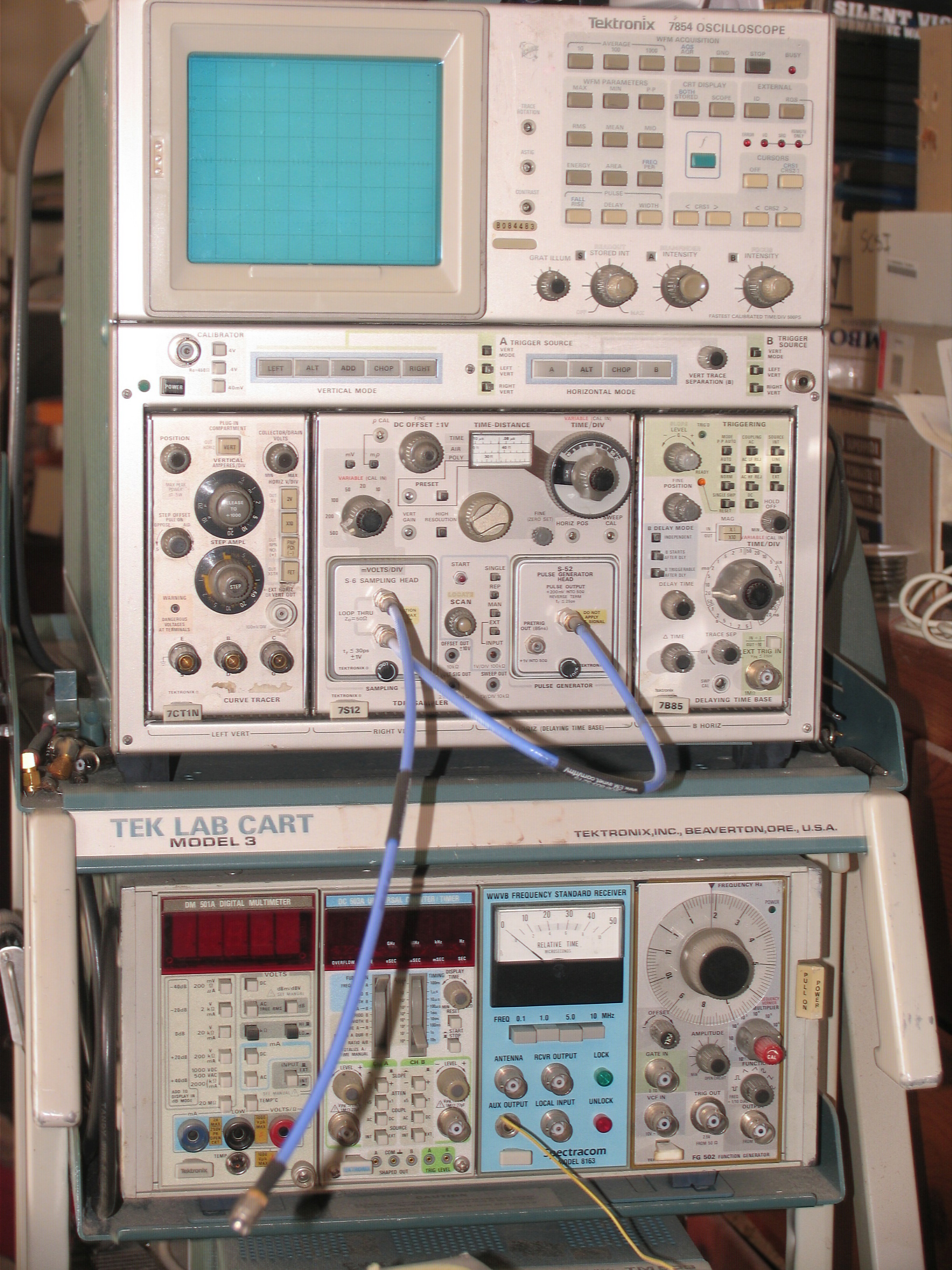|
Electrostatic Fieldmeter
An electrostatic fieldmeter, also called a static meter is a tool used in the static control industry. It is used for non-contact measurement of electrostatic charge on an object. It measures the force between the induced charges in a sensor and the charge present on the surface of an object. This force is converted to volts, measuring both the initial peak voltage and the rate at which it falls away. Operation: a charge monitoring probe is placed close (1 mm to 5 mm) to the surface to be measured and the probe body is driven to the same potential as the measured unknown by an electronic circuit. This achieves a high accuracy measurement that is virtually insensitive to variations in probe-to-surface distances. The technique also prevents arc-over between the probe and measured surface when measuring high voltages. Alternative method: The operation of the an electrostatic field meter is based on the charge-discharge process of an electrically floating electrode: Corona s ... [...More Info...] [...Related Items...] OR: [Wikipedia] [Google] [Baidu] |
Electrostatic Fieldmeter Simco FM300
Electrostatics is a branch of physics that studies electric charges at rest (static electricity). Since classical times, it has been known that some materials, such as amber, attract lightweight particles after rubbing. The Greek word for amber, (), was thus the source of the word 'electricity'. Electrostatic phenomena arise from the forces that electric charges exert on each other. Such forces are described by Coulomb's law. Even though electrostatically induced forces seem to be rather weak, some electrostatic forces are relatively large. The force between an electron and a proton, which together make up a hydrogen atom, is about 36 orders of magnitude stronger than the gravitational force acting between them. There are many examples of electrostatic phenomena, from those as simple as the attraction of plastic wrap to one's hand after it is removed from a package, to the apparently spontaneous explosion of grain silos, the damage of electronic components during manufacturin ... [...More Info...] [...Related Items...] OR: [Wikipedia] [Google] [Baidu] |
Volt
The volt (symbol: V) is the unit of electric potential, electric potential difference ( voltage), and electromotive force in the International System of Units (SI). It is named after the Italian physicist Alessandro Volta (1745–1827). Definition One volt is defined as the electric potential between two points of a conducting wire when an electric current of one ampere dissipates one watt of power between those points. Equivalently, it is the potential difference between two points that will impart one joule of energy per coulomb of charge that passes through it. It can be expressed in terms of SI base units ( m, kg, s, and A) as : \text = \frac = \frac = \frac. It can also be expressed as amperes times ohms (current times resistance, Ohm's law), webers per second (magnetic flux per time), watts per ampere (power per current), or joules per coulomb (energy per charge), which is also equivalent to electronvolts per elementary charge: : \text = \text\Omeg ... [...More Info...] [...Related Items...] OR: [Wikipedia] [Google] [Baidu] |
Coulombmeter
A Coulombmeter is a tool for measuring the electrostatic charge of a material. A Coulombmeter is used in combination with a Faraday cup or a metal probe for taking charge measures of a material. A Nanocoulombmeter is a Coulombmeter that is capable of measuring electrostatic charge down to the accuracy of a fraction of a nanocoulomb (nC). Electrostatic charge on an object can be measured by placing it into the Faraday Cup. The charge is transferred to the cup and displayed on the meter's display. The Faraday Cup of the Coulombmeter has an outer, grounded metal shield that surrounds an inner electrode. The inner electrode, which is electrically isolated from the shield, is connected to a meter to measure the charge. In the field of semiconductor design, a coulombmeter consists of a meter used in combination with a metal probe tip to pinpoint locations of excess charge on, for instance a semiconductor device. This application of a coulombmeter is useful because electrost ... [...More Info...] [...Related Items...] OR: [Wikipedia] [Google] [Baidu] |
Electrometer
An electrometer is an electrical instrument for measuring electric charge or electrical potential difference. There are many different types, ranging from historical handmade mechanical instruments to high-precision electronic devices. Modern electrometers based on vacuum tube or solid-state technology can be used to make voltage and charge measurements with very low leakage currents, down to 1 femtoampere. A simpler but related instrument, the electroscope, works on similar principles but only indicates the relative magnitudes of voltages or charges. Historical electrometers Gold-leaf electroscope The gold-leaf electroscope was one of the instruments used to indicate electric charge. It is still used for science demonstrations but has been superseded in most applications by electronic measuring instruments. The instrument consists of two thin leaves of gold foil suspended from an electrode. When the electrode is charged by induction or by contact, the leaves acquire s ... [...More Info...] [...Related Items...] OR: [Wikipedia] [Google] [Baidu] |
Electroscope
The electroscope is an early scientific instrument used to detect the presence of electric charge on a body. It detects charge by the movement of a test object due to the Coulomb electrostatic force on it. The amount of charge on an object is proportional to its voltage. The accumulation of enough charge to detect with an electroscope requires hundreds or thousands of volts, so electroscopes are used with high voltage sources such as static electricity and electrostatic machines. An electroscope can only give a rough indication of the quantity of charge; an instrument that measures electric charge quantitatively is called an electrometer. The electroscope was the first electrical measuring instrument. The first electroscope was a pivoted needle (called the '' versorium''), invented by British physician William Gilbert around 1600. a translation by P. Fleury Mottelay of William Gilbert (1600) ''Die Magnete'', London The pith-ball electroscope and the gold-leaf electroscop ... [...More Info...] [...Related Items...] OR: [Wikipedia] [Google] [Baidu] |
Electrostatic Voltmeter
Electrostatic voltmeter can refer to an electrostatic charge meter, known also as surface DC voltmeter, or to a voltmeter to measure large electrical potentials, traditionally called electrostatic voltmeter. Charge meter A surface DC voltmeter is an instrument that measures voltage with no electric charge transfer. It can accurately measure surface potential (voltage) on materials without making physical contact and so there is no electrostatic charge transfer or loading of the voltage source. Explanation Many voltage measurements cannot be made using conventional contacting voltmeters because they require charge transfer to the voltmeter, thus causing loading and modification of the source voltage. For example, when measuring voltage distribution on a dielectric surface, any measurement technique that requires charge transfer, no matter how small, will modify or destroy the actual data. Principle of operation In practice, an electrostatic charge monitoring probe is placed clo ... [...More Info...] [...Related Items...] OR: [Wikipedia] [Google] [Baidu] |
Faraday Cup
A Faraday cup is a metal (conductive) cup designed to catch charged particles in vacuum. The resulting current can be measured and used to determine the number of ions or electrons hitting the cup. The Faraday cup was named after Michael Faraday who first theorized ions around 1830. Examples of devices which use Faraday cups include space probes (Voyager 1, & 2, Parker Solar Probe, etc.) and mass spectrometers. Principle of operation When a beam or packet of ions hits the metallic body of the cup, the apparatus gains a small net charge while the ions are neutralized as the charge is transferred to the metal walls. The metal part can then be discharged to measure a small current proportional to the number of impinging ions. The Faraday cup is essentially part of a circuit where ions are the charge carriers in vacuum and it is the interface to the solid metal where electrons act as the charge carriers (as in most circuits). By measuring the electric current (the number of elec ... [...More Info...] [...Related Items...] OR: [Wikipedia] [Google] [Baidu] |
Electrical Meters
Electricity is the set of physical phenomena associated with the presence and motion of matter that has a property of electric charge. Electricity is related to magnetism, both being part of the phenomenon of electromagnetism, as described by Maxwell's equations. Various common phenomena are related to electricity, including lightning, static electricity, electric heating, electric discharges and many others. The presence of an electric charge, which can be either positive or negative, produces an electric field. The movement of electric charges is an electric current and produces a magnetic field. When a charge is placed in a location with a non-zero electric field, a force will act on it. The magnitude of this force is given by Coulomb's law. If the charge moves, the electric field would be doing work on the electric charge. Thus we can speak of electric potential at a certain point in space, which is equal to the work done by an external agent in carrying a unit of positi ... [...More Info...] [...Related Items...] OR: [Wikipedia] [Google] [Baidu] |
Electronic Test Equipment
Electronic test equipment is used to create signals and capture responses from electronic devices under test (DUTs). In this way, the proper operation of the DUT can be proven or faults in the device can be traced. Use of electronic test equipment is essential to any serious work on electronics systems. Practical electronics engineering and assembly requires the use of many different kinds of electronic test equipment ranging from the very simple and inexpensive (such as a test light consisting of just a light bulb and a test lead) to extremely complex and sophisticated such as automatic test equipment (ATE). ATE often includes many of these instruments in real and simulated forms. Generally, more advanced test gear is necessary when developing circuits and systems than is needed when doing production testing or when troubleshooting existing production units in the field. Types of test equipment Basic equipment The following items are used for basic measurement of voltages, c ... [...More Info...] [...Related Items...] OR: [Wikipedia] [Google] [Baidu] |
Electronics Work Tools
The field of electronics is a branch of physics and electrical engineering that deals with the emission, behaviour and effects of electrons using Electronic component, electronic devices. Electronics uses Passivity (engineering), active devices to control Electric current, electron flow by Amplifier, amplification and Rectifier, rectification, which distinguishes it from classical electrical engineering, which only uses Passive electronic component, passive effects such as Electrical resistance and conductance, resistance, capacitance and inductance to control electric current flow. Electronics has hugely influenced the development of modern society. The central driving force behind the entire electronics industry is the semiconductor industry sector, which has annual sales of over $481 billion as of 2018. The largest industry sector is e-commerce, which generated over $29 trillion in 2017. History and development Electronics has hugely influenced the development of modern s ... [...More Info...] [...Related Items...] OR: [Wikipedia] [Google] [Baidu] |






